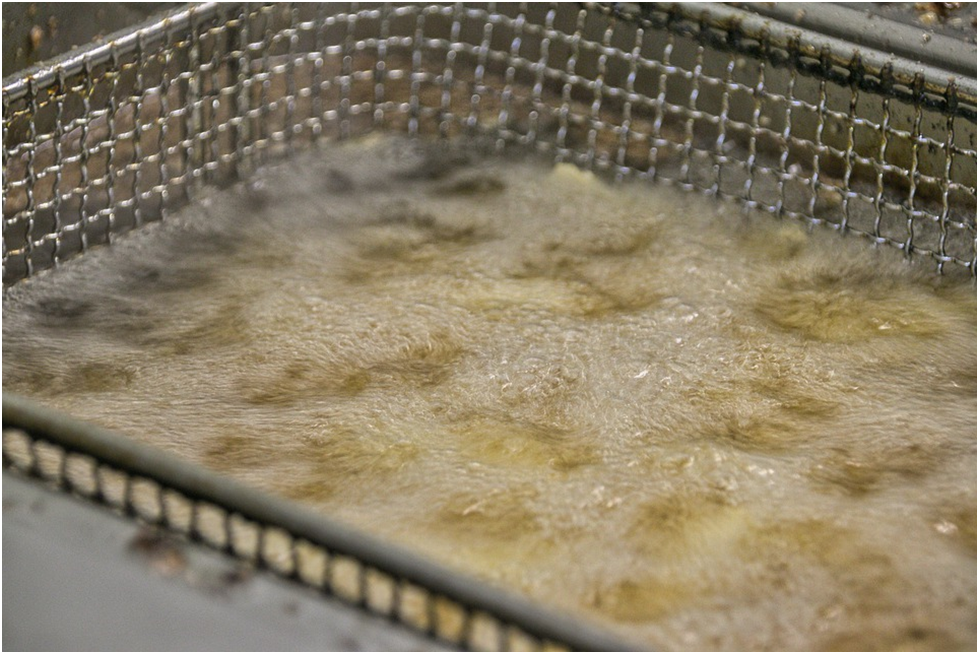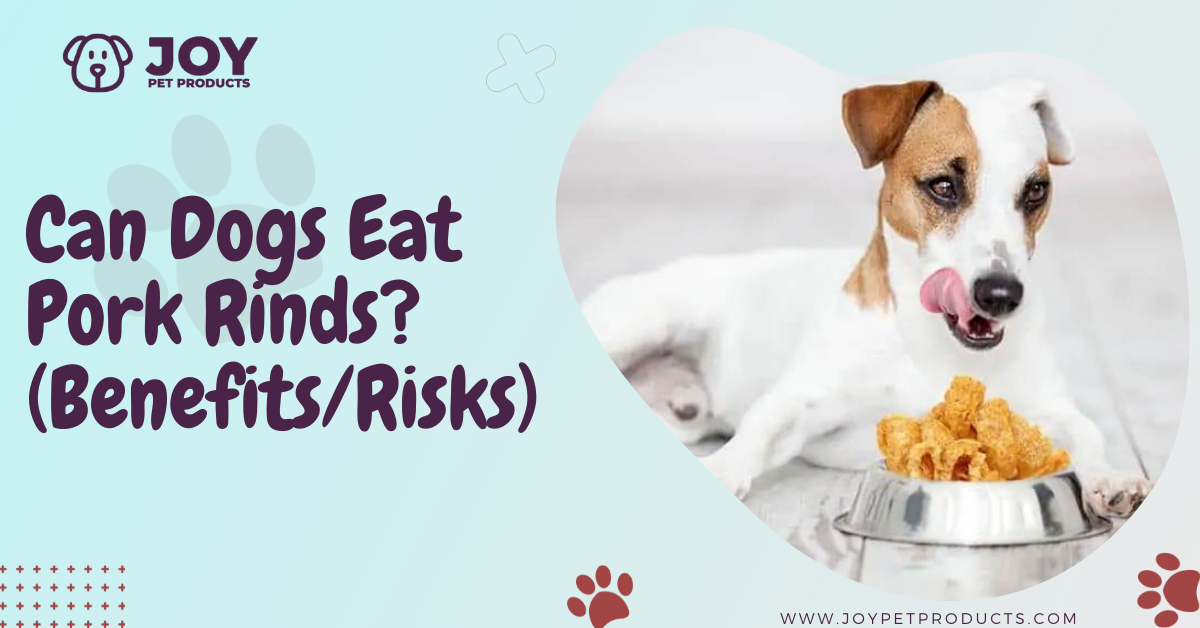Are you guilty of sharing tasty treats like pork rinds with your dog? Is it ok for your furry friend to eat this treat?
Pork rinds are a popular crispy deep-fried snack made by using pig skin. This savory snack is enjoyed by people worldwide. In the US, they are considered a staple in Southern cooking.
It is known as chicharrones in Mexico, scrunchions in Newfoundland, and kaeb moo in Thailand. Pork rinds also come in different flavors like barbeque, vinegar, and cinnamon sugar.
But can dogs eat pork rinds? No, this fried, seasoned, savory snack does not have a place in your dog’s diet. Your dog might accidentally eat a few pieces; it will most likely not cause any issues. Instead, the problem starts when you regularly treat them to pork rinds.
Let us look at what pork rinds are, what they contain, and the benefits and risks of feeding your dog this popular snack.
What are Pork Rinds and How are They Made?

The two main ingredients of pork rinds are pork skin and salt. The skin is boiled to soften the fat under the skin. Any additional layer of fat is removed once the skin cools down. Some may leave a layer of fat on for chunkier pieces depending on the brand.
The pork skin is cut into small pieces and dried at low temperatures. The brown, dried skin is then deep-fried at high temperature until the small piece starts puffing.
Lastly, the puffed pork skin pieces are seasoned with salt. Some brands also use spices or artificial flavors to season the skin. Some of the famous pork rinds flavors are:
- Barbeque
- Salt and vinegar
- Nacho cheese
- Sour cream and onion
- Chili and salt
- Jalapeno cheddar
Pork rinds are a big hit among people on a low-carb or keto diet. They are eaten as a substitute for savory snacks like potato chips. But are these classic and flavorful treats for your dogs to enjoy?
What is the Nutrition Profile of Pork Rinds?
Let us take the example of one small single-serving bag that contains 28 grams. The nutrients provided by this small serving are:
- Calories: 152
- Carbohydrate: 0 mg
- Fiber: 0 mg
- Protein: 17.2 mg
- Fat: 8.76 g
- Sodium: 510 mg
- Cholesterol: 26.6 mg
As seen above, the absence of carbs and high protein and fat content make the snack popular among keto diet followers. The snack, though, lacks vitamins and minerals.

Pork rinds are high in salt. A small serving alone gives you 510 mg of sodium. Some brands use spices such as onion and garlic powder for seasoning. These spices are not suitable for your dog’s health. Artificial flavoring is another ingredient why you should keep pork rinds away from your dog.
Can Dogs Eat Pork Rinds?
Now that you understand how pork rinds are made and what nutrients they offer, let us see why they are a bad snack option for dogs.
Regular consumption of pork rinds can significantly affect your dog’s health. For example, the skin is deep-fried to achieve the crunchy-puffed texture. Dogs have difficulty digesting fatty and fried foods. Their pancreas will work overtime to break down the food.

Pork rinds are tasty and thus popular among people. So you might want to share the experience with your pet. Especially when they are right there, staring at you, guilt-tripping you into giving them treats.
But a dog’s palette is not as developed as humans. They do not taste flavors as you do. They will not be able to differentiate between the spices as they have fewer taste buds. Spices like onion and garlic are, in fact, toxic for dogs.
The snack lacks nutrients like carbohydrates, vitamins, and minerals. The calories can add up and contribute to obesity among pets.
Pork rinds contain too much salt, even for a small serving size. With a high salt intake, your dog can become thirstier than usual. You might see other symptoms like high temperature or diarrhea.
How Much Calories do Pork Rinds have?
A small serving (57 g) of pork rinds has 152 calories. The number goes up to 310 calories for a medium serving (100 g). If you are giving the snack as a treat, it ideally should not be more than 10% of your dog’s diet.
So, if your dog has a daily calorie requirement of 600 calories, a single small serving will account for 25% of their calorie intake.
Pork rinds are not a meal substitute. They are high in sodium and lack essential nutrients. So, your dog will be consuming calories but still be hungry. This can further contribute to weight gain. Obese dogs are at higher risk of diabetes, heart disease, hypertension, and some types of cancer.
What are the Risks Associated with Pork Rinds?

Some of the risks associated with feeding pork rinds to your dog are:
1. Pancreatitis
When dogs are given high-fat, greasy, or processed food, the workload on the pancreas significantly increases. As a result, the organ can get inflamed and affect digestion. Older dogs and those that are fed an unhealthy diet are prone to this condition.
You will see symptoms like:
- Vomiting
- Abdominal pain
- Diarrhea
- Loss of appetite
- Lethargy
- Dehydration
Low-fat diets and easily digestible food, along with medications, are treatment options for pancreatitis.
2. Hemolytic Anemia
Onions and garlic are among the top reported causes of toxicity in dogs. They cause the breakdown of red blood cells and remove them from circulation quicker. Symptoms of anemia are:
- Red/brown urine
- Dark-colored poop
- Pale gums
- Increased heart rate
- Difficulty breathing
In severe cases, anemia can lead to organ damage, failure, and even death if not treated.

3. Sodium-Ion Poisoning
When your dog ingests a high amount of salt in less time, increased thirst will be the first reaction you will notice. If the dog does not have access to water, the cells in its body will start releasing water to match the salt level in the blood. This further can lead to a dog’s brain cells being damaged. You will see symptoms like:
- Headache
- Dizziness
- Tremors
- Seizures
- Lack of energy
- Nausea
- High fever
It is best to take your dog to an emergency clinic immediately if they show signs of sodium-ion poisoning.
Are There Any Benefits of Eating Pork Rinds?
The question is rhetorical at this point. If you are still wondering if dogs can eat pork rinds, the answer is firm no.
Even when it comes to humans, it is recommended to have the snack in moderation. It could contribute to health concerns like weight gain, high blood pressure, diabetes, and heart diseases. You can eat a small serving once in a while, but do not feed them to your dogs.
There are no benefits your canine friend gets from having pork rinds.
What to Do If a Dog Eats Pork Rinds?
The answer depends on the amount of pork rinds your dog has consumed and if they are showing any symptoms.
If your dog accidentally eats a few pieces, observe their behavior. They might experience discomfort, but a trip to the emergency clinic is not required. If the symptoms subside in cases of stomach upset in 24 hours, switch to an easy-to-digest diet. Make sure to keep your pet’s water bowl filled.
If your dog has shoved down a bag of pork rinds and its symptoms are on the extreme end, consult your vet immediately.
Can Dogs Eat Pork Safely?

If you want to include pork in your dog’s diet, ensure it is well-cooked and plain. Leave the spices and condiments you usually add to your recipes.
Avoid giving pork bones as they can be a choking hazard. Cooking makes the bones brittle; continuous chewing will cause them to break down into sharp pieces. Raw or undercooked pork is also dangerous as it can cause a parasitic infection called trichinosis.
If you are feeding pork to your dog for the first time, give them a small quantity. This is because pork has comparatively more calories per pound. As always, monitor your dog’s behavior after introducing them to new food.
Remember, well-cooked meat, no bones and seasoning, small quantity, and moderation are the way to safely include pork in your dog’s diet.
What are the Other Meat Alternatives for Dogs?

Dogs derive nutrition from both animal and plant sources. Therefore, you can feed them a balanced diet of grains, vegetables, and meat.
Meats such as chicken, turkey, lean ground beef, duck, lamb, and even salmon, are good protein sources for dogs. Some of the standard rules to follow when giving your pet meat are:
- Remove any excess fat from the meat. The skin goes off as well.
- Please do not give them raw meat; it should always be well-cooked.
- Separate the meat from the bones.
- Cook the meat fresh, do not deep-freeze meat dishes for dogs.
Please note meats such as chicken, lamb, and beef are common food allergens in dogs. Thus keep an eye on your dog once they have finished their meat-filled meal.
Summary
Can dogs eat pork rinds? No, dogs should not be given pork rinds.
The tasty, crunchy, savory deep-fried snack is addictive and comes in different flavors. But, it is also high in salt, fat, and calories. Also, depending on the brand, they can contain spices and artificial flavors.
Regular consumption of pork rinds by dogs can lead to weight gain, digestive issues, diabetes, pancreatitis, and anemia, among other health concerns.
Opt for other meat, vegetables, or fresh fruits options when looking for a way to treat your dog.
Heather Abraham is a professional blogger who owns two dogs, a cat, a parrot, and a leopard gecko. She has a connection with animals since she was a child. She shares her love for all pet breeds and provides information on pet food, toys, medications, beds, and everything else.
She is committed to learning about the internal workings of animals. Her work permits her to work closely with knowledgeable vets and obtain practical expertise in animal care. When she is not working, her love of animals continues in her writing. Her goal is to educate and uplift readers who also have a passion for animals through her writing.
